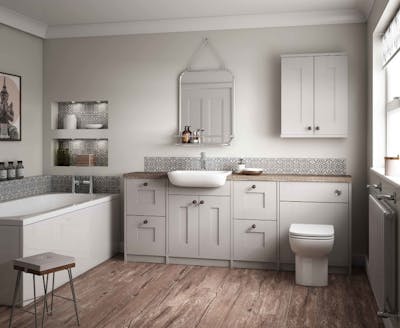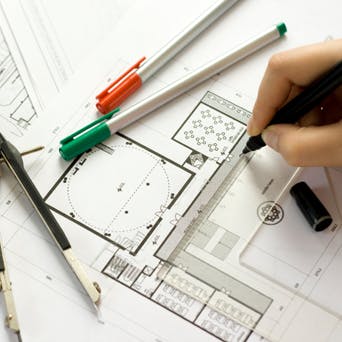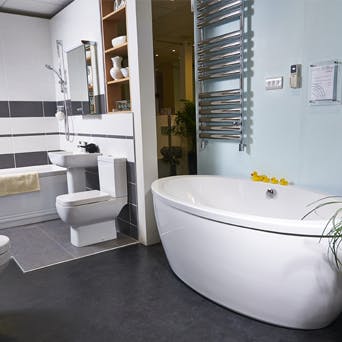An expert's guide to bathroom heating
Published: 25 September 2020 · Last Updated: 11 April 2024
Design and comfort are at the forefront of our minds when we are making decisions about what we would like to have fitted inside of our bathroom or shower designs.
And usually, those thoughts begin with ’Which type of bathing solution do I prefer? A bath, shower, or both?’
But, of course, design isn’t the only factor to take into consideration when we are thinking of what bathroom features we want to include inside of our bathing area.
Practicality comes into play and that could include making choices of where those bath features are best suited basing it around the layout of your bathroom.
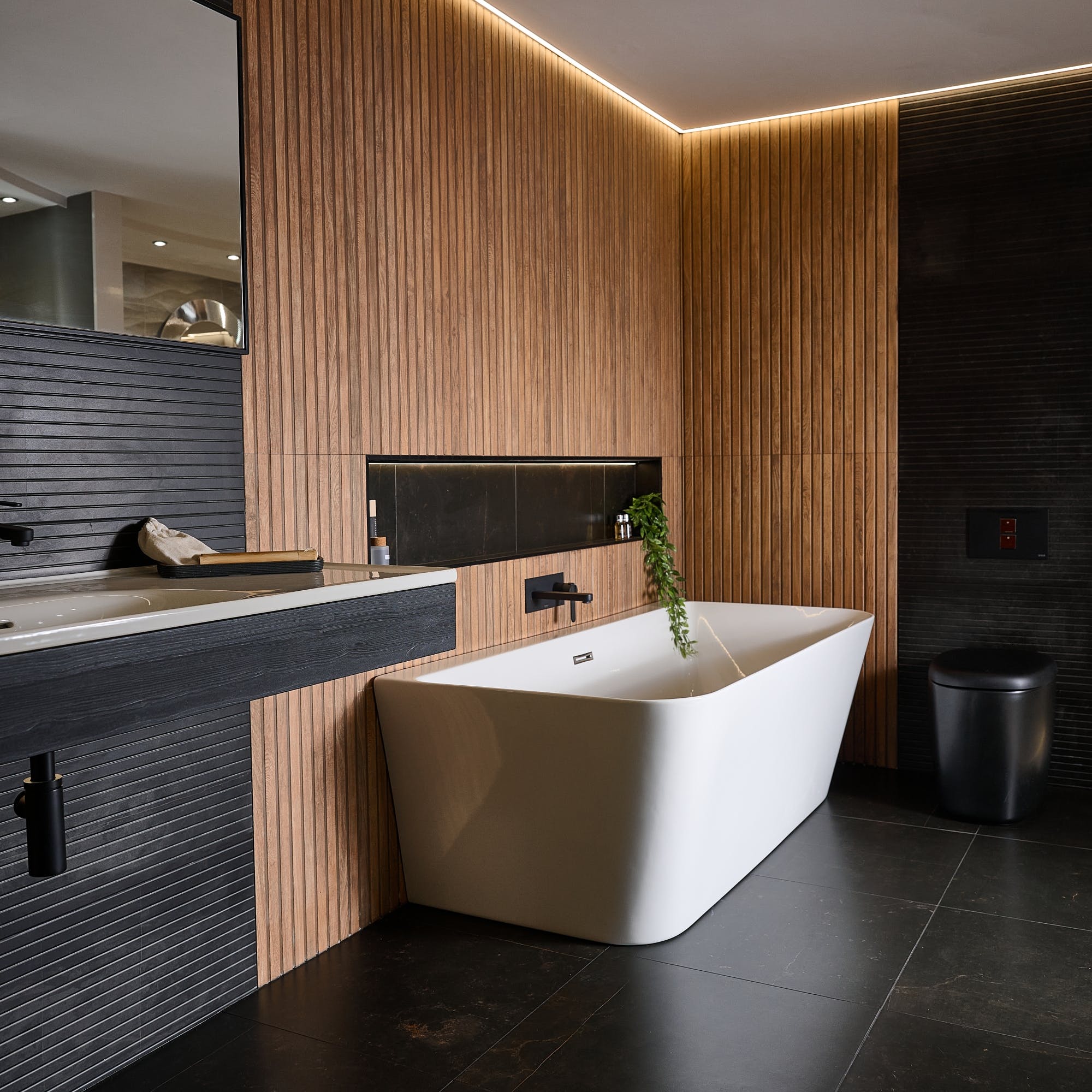
However that being said, there are also some key bath design features that contribute to a successful fully functioning bathroom.
And the one that we are going to concentrate on in this blog is heating in the bathroom.
So we can all agree that it is not enjoyable, having to step out into a bathroom area after having a warm shower or a soak in the bath.
Even during the winter months, you’d want to go into the bathing area with comfort knowing that you’ll be entering a warm area.
Aside from warming the bathroom area, heat within the bathroom combined with a proper ventilation system can prevent bathroom condensation and moisture problems therefore reducing the potential occurrence of mould and other problems within the bathroom.
As with anything, there are pros and cons and the same goes for heating within a bathroom, and some of the challenges that we may face in the bathroom area include:
> Limited space
> Fast heat loss (smaller bathrooms)
> Safety concerns
Those are just a few of the challenges that may face you when you’re in the middle of deciding on an appropriate heating option.
A variety of heating systems are available. Radiators, heated towel radiators, and underfloor heating are just a few of many!
The rest of this blog is now going to provide you with expert insight and an in-depth guide that we have put together for heating in a bathroom space, whether big or small.
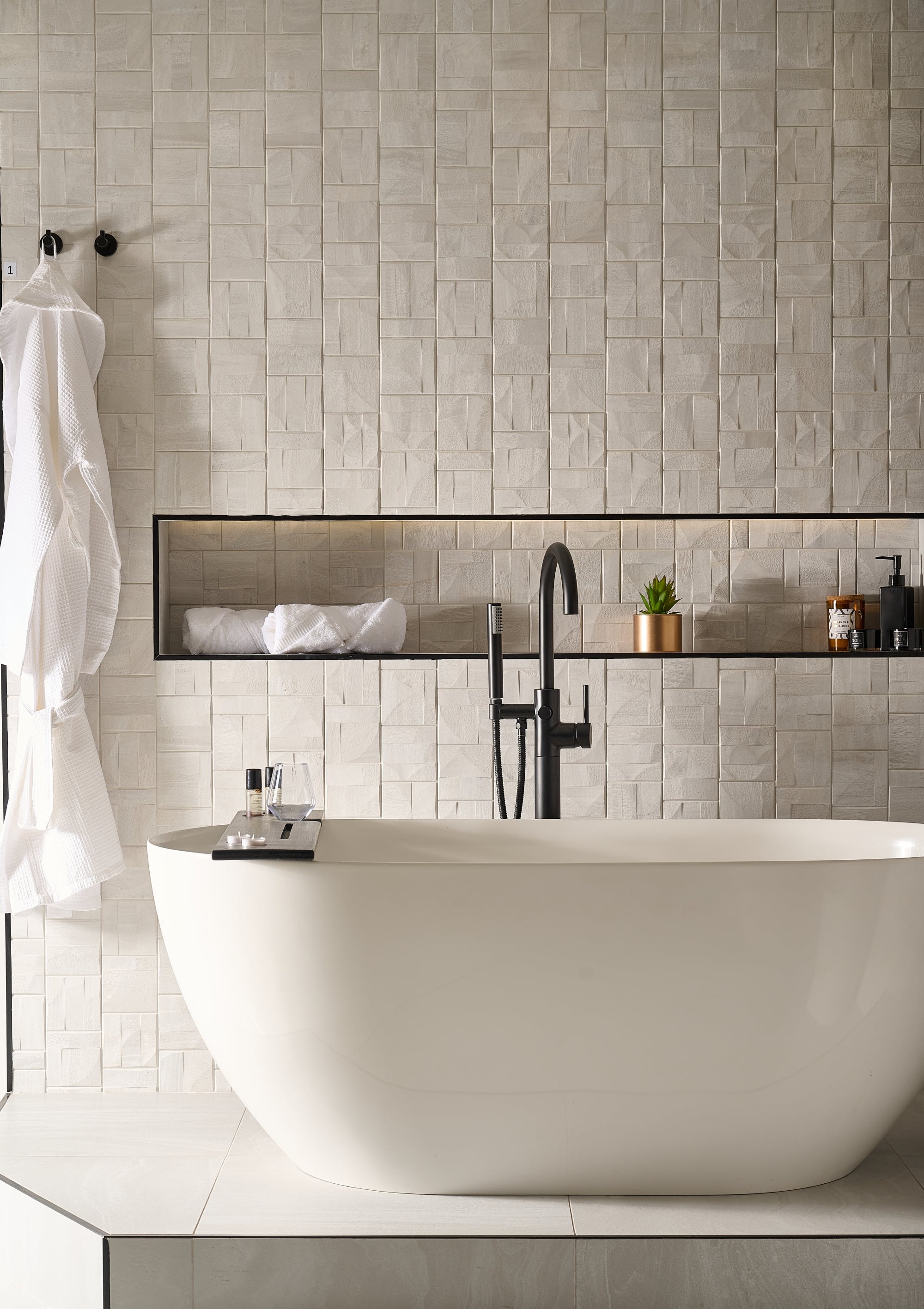
Understanding your bathroom's heating needs
The first consideration when deciding on the bathroom-appropriate heating system is to have a full understanding of the available space and get a taste of where the heater is most likely to be installed.
Bathroom size and layout
> Small bathrooms
Typically smaller bathroom designs require less heat output, compared to larger bathrooms. That being if there is a space limitation then you’ll be restricted on options.
The more popular options that people go for are either a heated towel rail or a vertical heater, these are fantastic, practical solutions for the small bathroom, especially the towel rail which offers a place for your flannel to be placed whilst keeping the room warm.
.jpg?auto=compress%2Cformat&cs=strip&ixlib=php-1.1.0&s=98bbd30cf9739012e483f4e78ebff37a)
> Large bathrooms
Larger bathrooms, in most cases, are going to have a bigger output than smaller bathrooms to ensure that they warm up the bathroom space. Despite needing higher energy output, they do offer flexible heating options when it comes to deciding which type of heater you would like to go for.
You could opt for two radiators within a bathroom space. One could be a towel warmer and the other a fitted large radiator or underfloor heating to have a consistently warm bathroom.
.jpg?auto=compress%2Cformat&cs=strip&ixlib=php-1.1.0&s=37f945e31b80bf39716958d1c3fc0d60)
> Layout
Design options are probably the first thought we think when we are in the process of refurbishing the bathroom, however, the layout of the bathroom is just as important, and that is because we would have to consider the functionality of the room and take into account the whereabouts of splash zones - also known as ‘wet areas’ - and as well as complying with the rules and regulations to avoid hazards.

Heat output requirements
When you have the measurements of your bathroom, one of the first things you have to do when it comes to choosing a heater is to determine how much heat is needed for the bathroom size and insulation.
In doing so, people usually calculate the BTU (British Thermal Unit) to determine how much heat is needed and the calculation is as follows.
.jpg?auto=compress%2Cformat&cs=strip&ixlib=php-1.1.0&s=3d5dd2d9729aa877d71a7a27f25f6a17)
> Zehnder's heat loss calculation (based on the average bathroom size)
> Stage 1: Take the room dimensions in meters, to get the volume
L X W X H = 2 m2 X 2 m2 X 2.4 m2 = 9.6 m3
> Stage 2: Heating requirements per room type
Bathroom heating requirement = 50
9.6m3 X 50 = 480 watts
Calculation = wattage - 80 watts
> Stage 3: Other factors for consideration
Is the property exposed? Add 15%
Does the room have large areas of glazing? Add 20%
Are the windows double-glazed? Add 10%
E.g - 480 + 15% + 10% = 600 watts
Calculating BTU = Watts X BTU (3.3412)
> 600 watts X 3.412 = 2,047.2 BTU
It is crucial to calculate the BTU of your bathroom, or any room for that matter when you’re considering installing a new radiator. The BTU will help you understand how much heating the bathroom requires.
The BTU as you can see through the formula above is that it takes into account the size and insulation of the bathroom, to get a true calculation of the heating required to heat the room.
Large rooms have more air within the room so it is advisable to opt for a radiator that has a higher BTU so it can remove any cold air within the room.
As for the smaller rooms, it requires less heating so going for one with a lower BTU rating will keep the bathroom warm without overheating the space.
Insulation within a bathroom is a key factor when contemplating which radiator is most suitable for your bathroom.
If the room has a good level of insulation then less heat can escape the room which may mean that the lower rating BTU radiator would be required, but effectively the room would maintain a desired room temperature which is brilliant for efficiency.
On the other hand, a poorly insulated bathroom allows heat to escape easily and can require a higher BTU radiator.
Existing heating system
Knowing how your bathroom is connected is a key element when it comes to deciding on which type of bathroom heater you’re going for.
It boils down to two types of systems that it could be. Either it is connected as part of the central heating system or it can perform as an independent solution.
Once you know, you’ll be in a position to make a better-informed decision and pick the most convenient, cost-effective radiator solution.
Besides that, knowing how your bathroom is wired up is good practice as it will help for any future remodelling or if there are any problems with the plumbing you could have a better idea of what went wrong.
But back to why it is important to know your existing bathroom heating solution, is that if your bathroom is connected to central heating then you’ll want to opt for a radiator that is compatible with your system, so it can seamlessly integrate. You can avoid any huge costs and unforeseen problems.
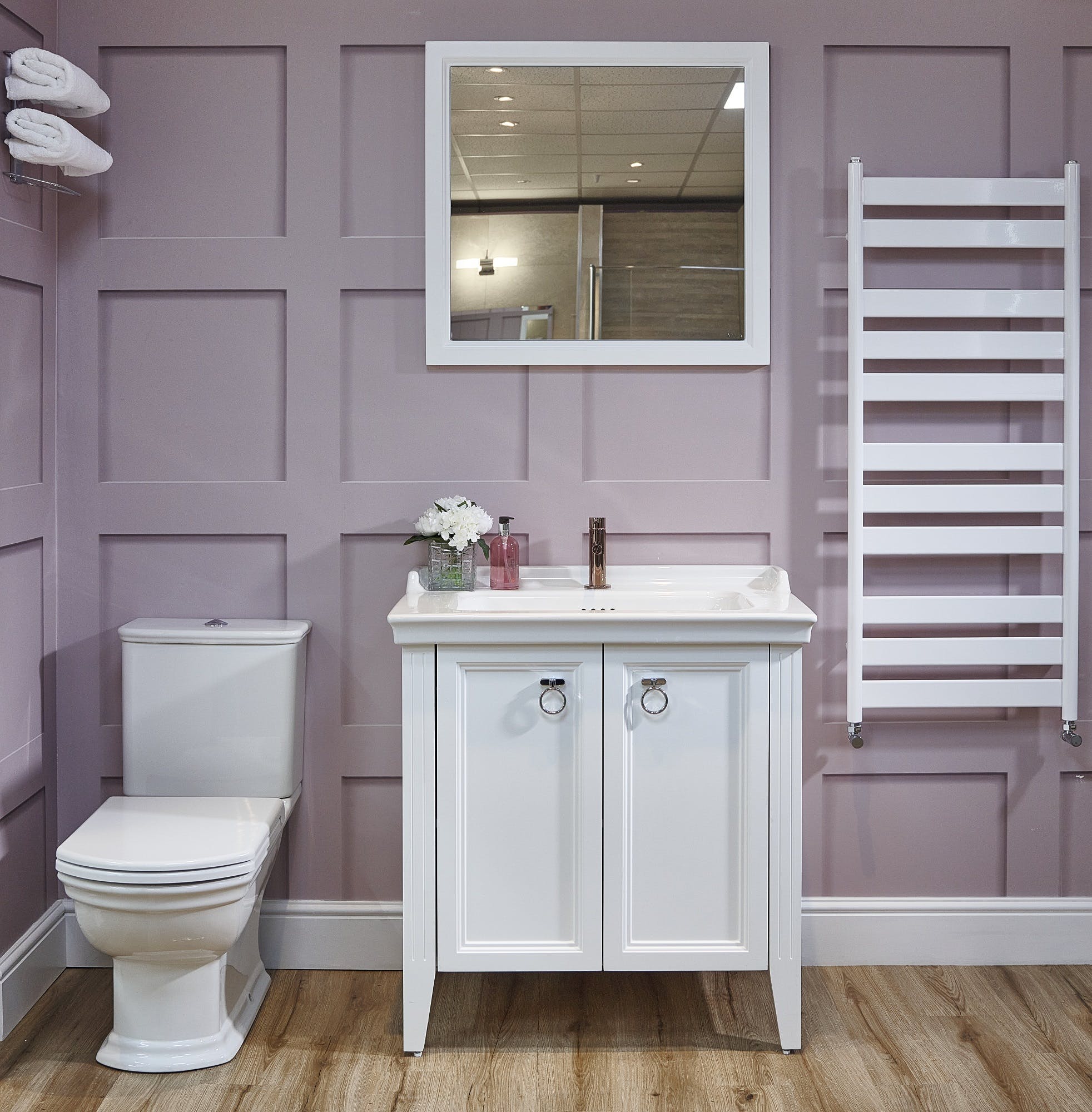
The same goes for an independent solution and is because if it uses electricity, then you’ll need to wire it to a radiator that is specifically designed for that energy source.
As with most things, you’ll want to figure out how you can control the heating within the bathroom and how much control you have that will allow you to make adjustments.
With a central heating system, the bathroom’s heat is controlled by the existing home thermostat which controls heating across the entire home. So, if you’ve turned down the heating during the day, expect not to be met with warmth when you enter your bathroom.
As for an electric heating installation, it could have a separate control system that is specific to the bathroom, providing you with much more control over the bathroom heat at any given time of day.
Lifestyle and usage
As a consideration of what type of bathroom radiator you decide for the bathroom can depend on the lifestyle and usage of the bathroom.
You’ll have to take note of the number of users of the bathroom, usage i.e. the activities - quick or long baths.
Knowing this will help you to see the heating needs of your bathroom. For example, if your bathroom is used for extended periods of the day like multiple showers, then a radiator that is energy efficient and has a higher BTU is probably the best solution for the bathroom. It will give the bathroom consistent warmth and ensure comfort throughout the day.
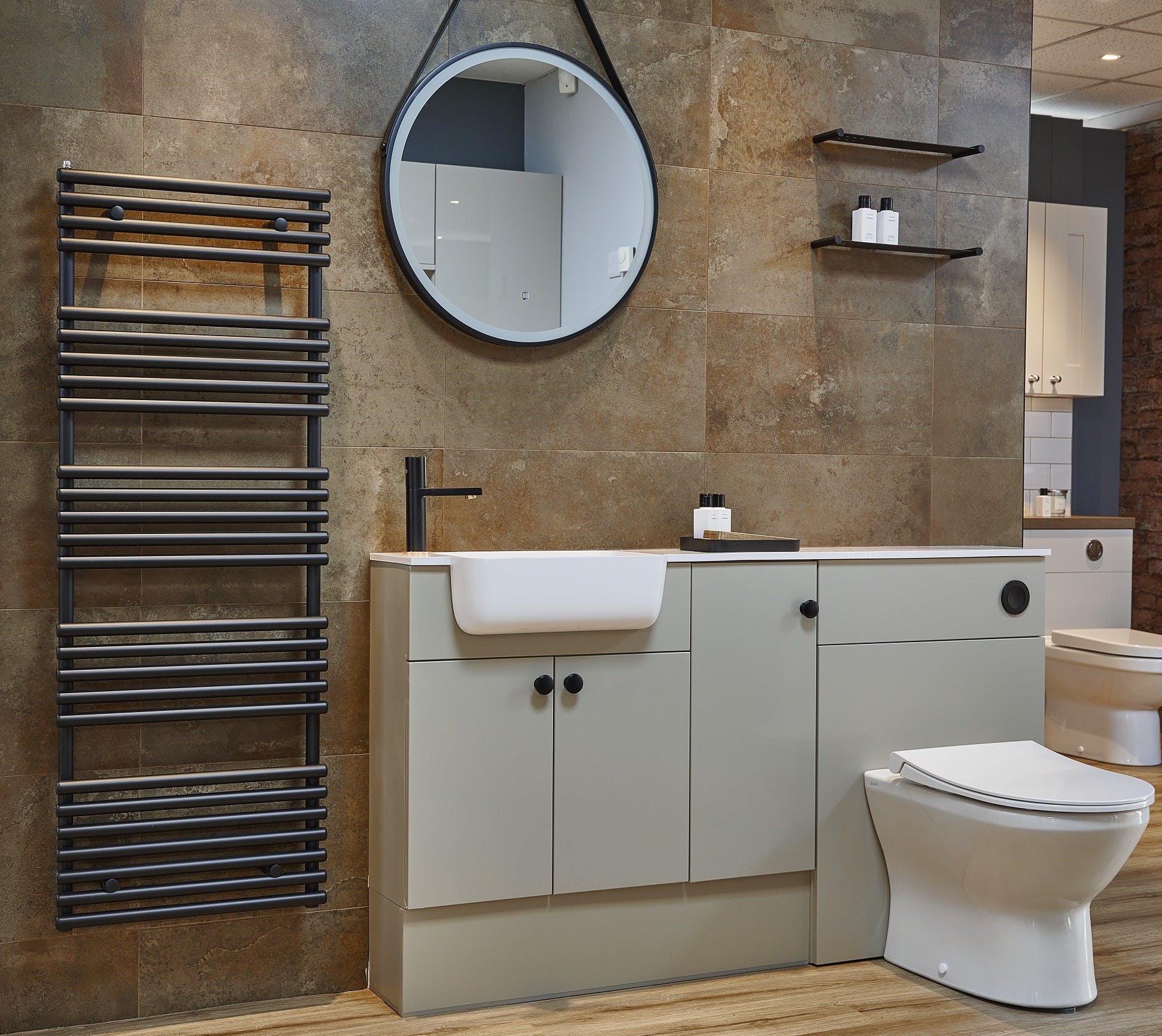
> Towel radiators
Depending on the number of people that use the bathroom, a towel warmer could be of preference as it gives you a place to dry your towels after use and is quite aesthetically pleasing. Alternatively, a standard radiator is still good enough for you to place your towels.
.jpg?auto=compress%2Cformat&cs=strip&ixlib=php-1.1.0&s=ccd77c9afe58b18cf49c595e6da29b85)
> Design preferences
Carrying on with design preferences with bathroom radiators, you have a wide range of available options, from the modern styled radiators with sleek lines or a polished finish for example. Whichever it is you decide to go for, it should be in line with your bathroom design.
.jpg?auto=compress%2Cformat&cs=strip&ixlib=php-1.1.0&s=861a406c81424f6c13ebe8a5c7c65b44)
> Available space
Overall the available space dictates a lot of the decisions that are made regarding the bathroom heater and that is because a bathroom could be small therefore a vertical radiator installation utilises the wall space, and maximises the limited space within the bathroom.
The larger bathroom as we mentioned in this bathroom gives you flexibility in choosing which radiator size and style.
Budget
Once you have gathered as much information as you can about your bathroom how it is wired up and how much it needs to output to be sufficient.
Now it is about finding the most appropriate heater for the bathroom with the available budget and that is what we’re going to get into is what kind of cost you can expect.
Once you have got the information of your bathroom’s heating needs as mentioned above then it comes down now to the cost of the radiator that you will need to go for.
Let's take a look at some of the price options that are available to us.
For example, a bathroom that would need up to 3500 BTU (approximately 1025 watts) would cover the heat needed for a small, average and large bathroom. Here are some of the price ranges for different heat options:
> Heated towel rail (£42 - £1900+)
> Radiators (£16 - £556+)
> Underfloor heating (£2,300 - £11,000)
> Electric fan (£158 - £303+)
> Infrared heaters (£199 - £799+)
* The price ranges that we have placed above are from reliable providers with a range of brands listed.
Another solution that is available to you is to ask the advice of professionals who will be able to point you in the right direction of the best possible options that can be installed as part of your bathroom.
Popular bathroom heating options
Let’s have a look at all the bathroom heating options that we have at our disposal.
Heating towel rails
Heated towel rails are often associated with luxury and opulent bathroom designs. Available in various styles and finishes it adds that magical luxurious touch to a bathroom.
They’re a popular design that people take seriously into account for their bathroom.
As mentioned in the name, heated towel rails are designed to warm up or dry your towels. This can be part of your showering transformation as it enhances the experience delightfully.
It also heats your damp towel and helps to heat and dry the air reducing the risk of bathroom condensation and bathroom mould, ultimately creating a healthier environment.
A major plus point is that they are fast to heat up, so you can surely enjoy a warm bathroom in a short space of time.
Aside the all the good things that come with a heated towel rail, they can be expensive to install depending on which one you decide to go for. Other than that, it would be the labour that would be the majority of the cost as you would need an electrician or plumber depending on which system you have to install the heating option in for you, as it could prove to be quite a complex fitting.
Taking this away from you another option available is to let the professionals who can help you as part of our full design and fit service, to choose which option would be best suited for your bathroom space.
While some of them are energy-efficient, you do have to make sure they are not left consistently on - that is if they’re electrically wired in. We would advise that you look for models with timers or those with thermostats with those parameters in place, giving you full control over the heating within your bathroom area.
Radiators
Radiators are the most common heating source that are found in the majority of people’s homes in this day and age.
Radiators are connected to the central heating system of the home, circulating hot water through pipes that are installed under the floor and walls.
Despite the complexity of the heating system, radiators are still the most reliable way to heat your home.
Providing efficient heat distribution, radiators create heat that rises from the radiator and circulates the room.
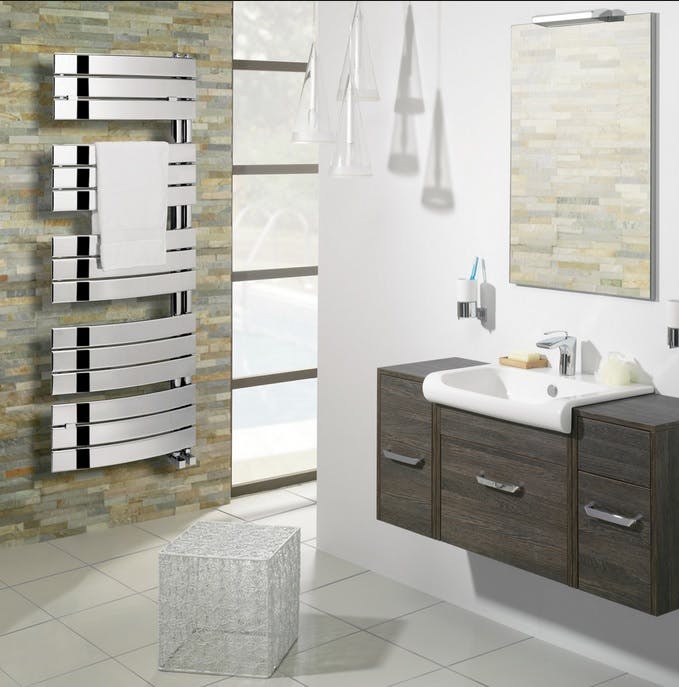
As for maintenance and durability of a radiator, as long as it is well looked after, that will include, regularly wiping the surface to remove moisture and dust, as well as bleeding the radiator, to get rid of trapped air and improve heat efficiency.
Radiators are pretty easy to control with a central thermostat, this gives consistency throughout the home, which relieves you of having multiple controls for different areas of your bathroom.
A drawback is that if you do feel like turning up the heating within your bathroom then you do have to consider the rest of the home.
Just like heated towel rails, you can hang your towels over radiators to dry them, although bare it in mind that they’re not as efficient as the towel ‘rails’, but at least it will provide you with another drying place.
You’ll be happy to know that radiators are not one-size-fits-all and that they come in various styles and sizes that will match your bathroom size, layout, and design.
Electric fan heaters
Other options that are available to us that can help to heat a bathroom are electric fan heaters.
Now this bathroom heating source comes with a healthy balance of pros and cons that can be explored depending on your situation, and preference.
Electric heaters are a convenient way to heat a bathroom. They give off heat instantly, are excellent for heating a cold room - especially in the morning fortaking the chilliness off, making your bathroom more comfortable.
They are portable so you can use them in different areas of your home, but better yet you can easily move them around different areas to boost the heat within the room. This can be a big help for huge bathrooms as you can blast the heat in especially cold areas.
Just like the other heating options that we have mentioned, electric heaters are excellent machines that can help to reduce condensation and moisture in bathrooms thanks to the fan function that is installed.
Although it sounds all positive it is classed as one of the cheaper ‘heating’ options for the bathroom. It is not a sustainable heating alternative as its longevity isn’t like the other heating sources.
If you’re not careful or consistently monitor the usage of your electric heater it can significantly add to your electricity bill.
They also come with a fire risk especially if flammable materials like towels are placed close to the heater. It is advisable to keep them at a safe distance, away from materials that can catch a blaze.
Electric heaters are a short-term solution for a bathroom and can help on days when it is extra frosty in the bathroom.
Underfloor heating
Just imagine walking into a warm tiled bathroom. That sounds like a treat for your feet. Underfloor heating is the next bathroom heating option that we are going to have an in-depth look at.
Underfloor heating is a bit different to your ‘normal’ radiators and how they work. Underfloor heating warms the floor and then the heat radiates and makes its way upwards in the room, giving the room a much more gentle warm radiation around the around.
Certainly a space saver! Underfloor heating does not require any wall space and is installed underneath the tiles of the bathroom, meaning you can put up that picture or the storage unit instead of a bulky radiator. This is particularly beneficial for the smaller bathroom spaces.
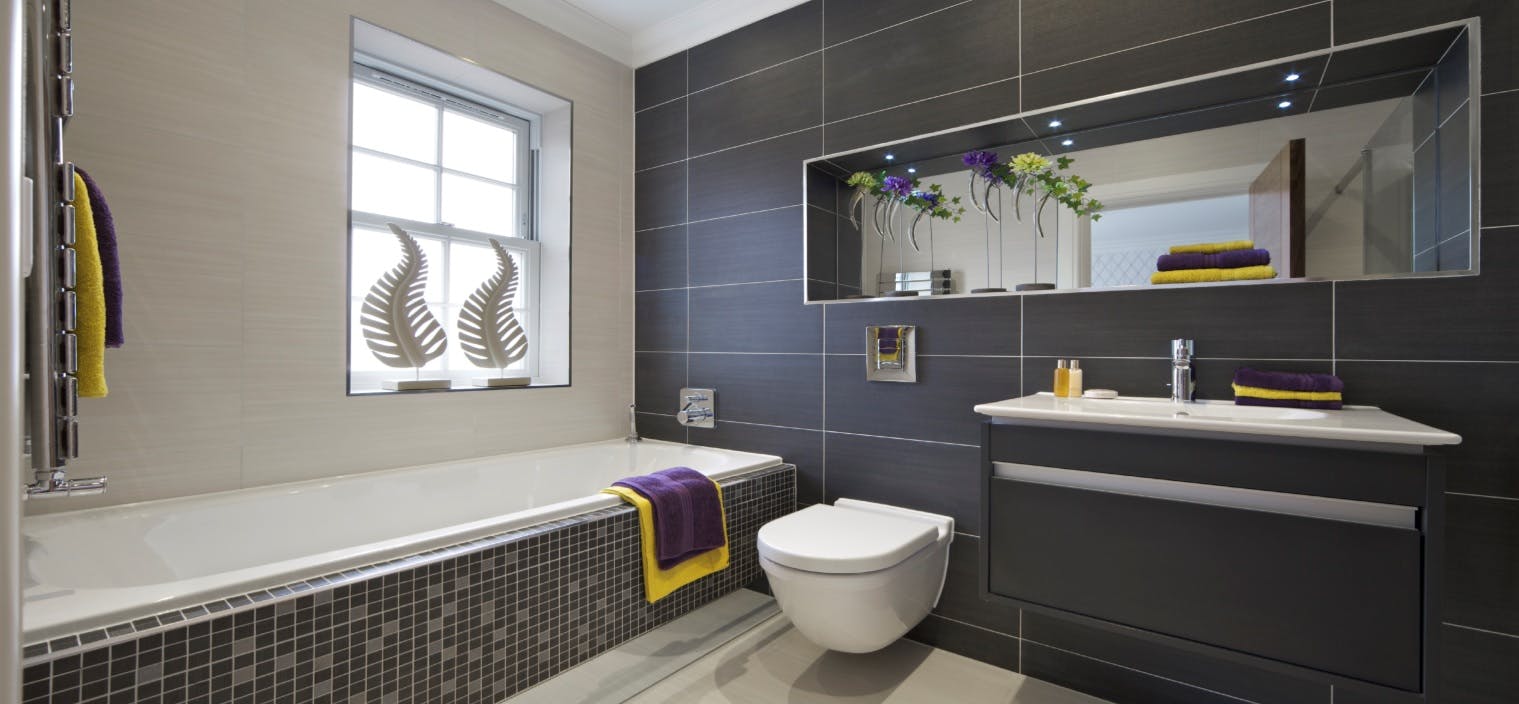
A super-friendly option, suiting all members of the bathroom. Underfloor heating gives users extra control over the temperature within the bathroom, giving you the ability to tune the heat to match your desire!
You might be thinking that it is limited to certain floor covering, but to get rid of those concerns, it is most definitely not the case as underfloor heating can be installed under floors such as vinyl, laminate, and even engineered wood, to name a few.
You could ask one of our design professionals who could advise further at a design appointment.
Even though underfloor heating is an awesome heat option for the bathroom, the installation of underfloor heating can be costly especially if you have to renovate the floor, and how it can be quite an expense especially if you’re having to renovate the floor.
Do also take into consideration the fact that it generally does require little maintenance but when it does need having a look at due to its complexity it may include a few labour, and material costs.
Underfloor heating is a luxurious heating option that can heat a bathroom and comfort for the users. One for consideration if you’re opting for a long-term bathroom heating solution.
Infrared heaters
The final bathroom heating option that we think you can add to your list of bathroom radiator options is infrared heaters.
They’re more of a unique bathroom heat option because of how they warm up a bathroom but let
Wired up independently, infrared heaters are fantastic as they can focus on heating areas of the bathroom that especially need warmth.
What is great about infrared installation regardless of having a window open, if there is a cold spot in a bathroom, then it can look to counter this and heat that spot without the heat getting lost.
Infrared heaters are really quick when it comes to heating areas reaching the desired temperatures quickly. This is ideal as it can take the cold out of a bathroom, this would be a huge help, mostly during those winter mornings.
Classed as an energy-efficient heat source, because of its unique approach to zone heating rather than how fast it operates to heat that area, it does not need to be switched on for a long period. They can save you a pretty penny being as much as up to 60% cost-effective in comparison to other bathroom heating options.
On the flip side, infrared heaters do work better if they are installed in smaller bathrooms. If you were to opt for this inside of a bigger bathroom, you’d most likely require multiple panels and add another heating source.
Design-wise infrared panels aren’t the most aesthetically pleasing items to have installed as part of the bathroom design.
Choosing the right systems
When it boils down to choosing which bathroom radiator is the most suitable for your bathroom, there is a bit of a process that you should go through first.
Matching heating needs options
Firstly you’d think about the bathroom size and that would give you the BTU/ wattage depending on how you have calculated this.
Then it would be to look at what exactly your needs are. Is it to heat your whole bathroom, or is it an area where there is a cold spot that needs warming up?
Consider aesthetics and design
Once you have bottomed out your needs for the bathroom, now it is time to go into the options that are available to you. The fun part - design.
Always keep in mind the size of your bathroom, when you’re looking at heating options. For example, if you have a small bathroom installation it would be more appropriate to have:
> Towel radiators
> Infrared heaters
> Electric heaters
These are just a few but you’re not limited by these options, it would be best to speak with design professionals who can help you choose the best option for your small bathroom.
As for a large bathroom size, they can be complemented by heating options such as:
> Radiators
> Underfloor heating
> A few heated towel rails
Larger bathroom sizes do give you the flexibility to go for different heating options.
Installation and maintenance
This is where you have to take extra caution when choosing a heat option for your bathroom.
At this point, you know how your bathroom is wired up whether it is independently or it is part of a central heating system.
So it would be worth it when considering your options for heating and how complex or easy it would be to install it as part of the bathroom.
So for instance towel radiators can be installed either as part of the central heating system or independently if it is electric.
Fitting an electric heated towel radiator can roughly cost £150 - £250 and hot water(central heating) can cost you between £250 - £350. According to Checkatrade’s how much does it cost to install heated towel rails?
You would also need to find out the maintenance of the heating option and how much it would cost you to maintain it over the years, then weigh up the pros and cons of what would be the best option going forward.
Bathroom heat calculation chart
This chart is a guide for users to see how much heat is needed for their bathroom once they have the measurements, to help them see what radiators and options they could opt for.
1. Bathroom size:
The first process of working out your heat is to measure up the size of your bathroom. Looking at the chart you can then see which range your bathroom fits in and how much heat it needs.
2. Insulation level:
It is worth noting that you need to know your bathroom’s insulation level. As stated in the chart, a well-insulated bathroom will require a lower BTU than a poorly insulated bathroom, as it will have poor heat retention.
3. Temperature difference:
The next step is to calculate the difference between your desired bathroom temperature and the average temperature of the bathroom, then use the chart which range matches the difference.
4. Estimated BTU output needed:
The final step of finding out which heater would be most appropriate for the bathroom is finding the mid-point of where all of your other findings (size, insulation level, and temperature difference) meet or where they’re closest in range for a recommended BTU.
Or
1. Bathrooms size:
The first step in calculating BTU for a bathroom is to calculate the size of your bathroom, and that would be to get the L X W X H and this gives you the total volume of the room.
2. Multiply by the heating requirement
The next step is to calculate the heat required for the room and multiply it by the size of the room.
So in the UK bathrooms are measured using the delta T50 rating (Average in flow temperature of a boiler or central heating system, and its output temperature of a radiator.)
Let's say the average radiator temperature is 70 degrees you then minus that by 20 degrees giving you - delta t50. (70c - 20c =t50)
Calculating the heat requirement is multiply the volume by t50 and that will give you the watts required for the bathroom.
3. Other considerations
Your bathroom could require more watts or BTU based on a few factors, including:
A. If the property is exposed? Increase wattage by 15%
B. If the bathroom has an area of glazing? Increase by 20%
C. Are the windows double-glazed? If they are double glazed decrease by 10%
For instance, if your bathroom is both exposed and has an area of glazing then you'd add both percentages together (add 35% to the calculated watts)
Or let’s say all 3 apply then (15 + 20 - 10) = 25% increase.
4. Converting the watts into BTU
Now you have the required watts for a heater in the room.
To make life easier for you, it is worthwhile having both the watts and BTU calculations.
e.g 600watts X 3.412 = 2047.2 BTU
BTU = 2,047.2
Example (using the chart) (h3)
> 6m2 bathroom with good insulation
> Your desired temperature is 22c and the current temperature is 15c (difference is 7c)
> Find the range 4.65 - 9.29m2 under well-insulated.
> Then, move across to the temperature range closest to 7c (could include either 11c or less, or 16c or more)
> Estimated BTU option - 540 - 820W)
Making the right radiator choice
When you’re deciding to choose the right radiator choice for your bathroom you must follow the steps that are involved to get the bathrooms required BTU. We have provided two ways we can get the watts and BTU, as a way how to double-check if you’re right.
It is always good practice to contact professionals who can help you calculate the room’s BTU and watts.
How can More Bathrooms help you choose the right radiator?
We have a team of bathroom experts who cover every specification from design to installation.
Our fully project-managed service will cover calculating the bathroom's BTU as part of the original survey that our designers.
Book a free
design appointment or
call us today!
FAQ's
Is there a specific type of heating system ideal for small bathrooms?
The most appropriate heat systems for bathrooms include:
> Heated towel rails - great for small bathrooms, don’t take up a lot of space, provide sufficient warmth and can dry towels excellently.
> Radiators - Traditional heat sources for bathrooms, that come in various sizes. If you’re looking to heat your small bathroom and have a central heating system then a a radiator option is probably one of the better heating solutions. Over the years radiators connected to the central heating system have been more efficient than other heating sources.
> Underfloor heating - A more luxurious option to heat your bathrooms and is efficient. This gives a balanced heat distribution throughout the room and can be controlled with a thermostat.
What are some budget-friendly tips for keeping my bathroom warm without a dedicated heating system?
Taking shorter showers can help massively in keeping your bathroom warm and it is Eco-friendly as the less water that is used for the shower.
Another easy tip that you can look to implement today is to close the bathroom door whenever it is in use or out of use will help to keep the warm within the bathroom.
We also advise that you strategically place bathroom rugs in places that can help the bathroom retain heat.
If your bathroom is of an electric source then it is worth opting for a heated towel source as they are efficient, and typically provide enough heat for a bathroom, size depending.
Share this Post




.jpg?auto=compress%2Cformat&cs=strip&ixlib=php-1.1.0&s=98bbd30cf9739012e483f4e78ebff37a)
.jpg?auto=compress%2Cformat&cs=strip&ixlib=php-1.1.0&s=37f945e31b80bf39716958d1c3fc0d60)

.jpg?auto=compress%2Cformat&cs=strip&ixlib=php-1.1.0&s=3d5dd2d9729aa877d71a7a27f25f6a17)


.jpg?auto=compress%2Cformat&cs=strip&ixlib=php-1.1.0&s=ccd77c9afe58b18cf49c595e6da29b85)
.jpg?auto=compress%2Cformat&cs=strip&ixlib=php-1.1.0&s=861a406c81424f6c13ebe8a5c7c65b44)


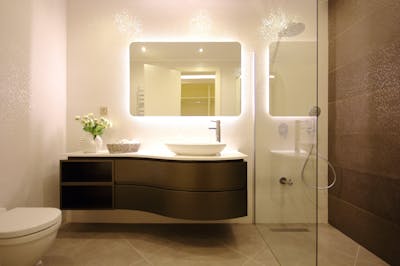
.jpg?auto=compress%2Cformat&cs=strip&fit=clip&h=400&ixlib=php-1.1.0&w=400&s=650efd70d263e5302d2f210efde25839)
